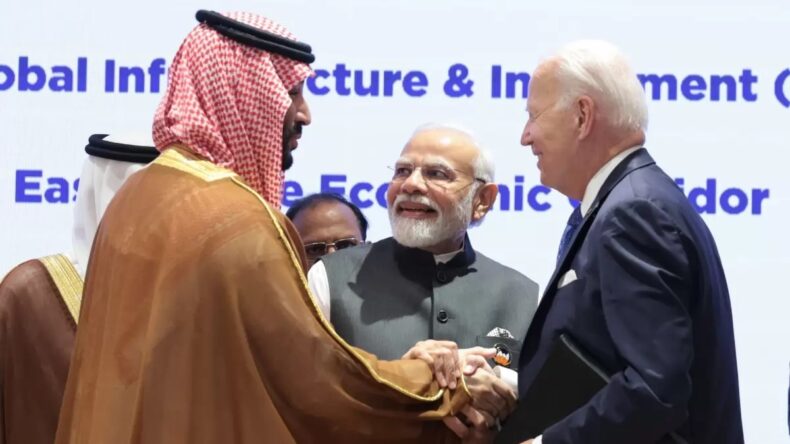Amidst the victorious cheering for the passing of the New Delhi Declaration, on the sidelines of the G20 Summit, India, Italy, France, Germany, European Union, USA and Saudi Arabia signed a Memorandum of Understanding for the creation of an India-Middle East-Europe Corridor(IMEC), a rail and shipping network.

The IMEC
The negotiations for IMEC, according to experts, had begun back in May when the National Security Advisors of India, Saudi Arabia, USA and UAE had met in Riyadh.
The project will be developed by the G7 Nations under the “Partnership for Global Infrastructure Investment” which is a fund created by the developed nations to facilitate development in the underdeveloped and developing countries. While there is no official announcement yet on the estimated expenditure, it is expected that around 20 Billion $ will be spent on it.
The corridor will include a ship-to-rail transit network to make transport easier and cheaper along with a cable network for digital and electrical connectivity. The plan also aims to lay down pipelines for transfer of clean hydrogen.
The project will consist of two corridors. The Eastern Corridor will connect India with the Gulf countries and the Northern Corridor will connect Arabian Gulf with Europe. It will also allow for goods to pass through Jordan, Israel and UAE.
The IMEC, if successfully implemented will integrate regions of India, Europe and West Asia into a tight network of global interdependency and partnership. It will also give boost to the economies of developed nations as private investors will be brought in for the project’s planning and implementation.
China’s Belt and Road Initiative

The BRI or The New Silk Route, also called the One Belt and One Road Initiative was launched by Chinese President Xi Jinping in 2013.
This project aims to develop a vast network of railways, highways and energy pipelines across Asia, Europe, Africa and Latin America. It has signed with over 150 countries and 30 international organisations. It is believed that China has already spent 1 trillion $ on the project and will be spending up to 8 trillion $ more.
Global Implications
Both projects, on the face of it are commercial infrastructure projects with massive potential to have a multiplier effect on domestic economies by boosting trade and increasing employment. However, the geopolitical objectives of these networked projects are also multifaceted and massive in their impact.
China’s BRI has successfully earned the characteristic of engaging in “Debt Trap Diplomacy”.
A study analysed that over one hundred debt financing contracts had been signed by China with foreign governments and found that these contracts often contained clauses that restricted restructuring of debt with the famous “Paris Club”.
The BRI is not only viewed as China’s manifestation of challenging America’s hegemony by creating dependency on itself but also entering into the sphere of influence of India, its regional nemesis.
The IMEC, though details unknown, is expected to counter China’s debt trap diplomacy through the increasing trust that nations are putting into India’s abilities and the funds that the developed countries have promised to invest.
Additionally, the IMEC comes at a time when Chinese influence in West Asia is becoming more prominent as a result of America’s exit. Thus, IMEC then provides scope for West Asia to get reintegrated with the West and India and reformulate its ties on newer terms.
Thus, while the global appreciation for IMEC has been extremely generous and its potential to counter BRI, a very strongly believed argument, IMEC’s potential and its true objectives will only be seen when the project is rolled out.
Till then, the narrative created strengthens the imagery of the countries who stand in opposition to China.













